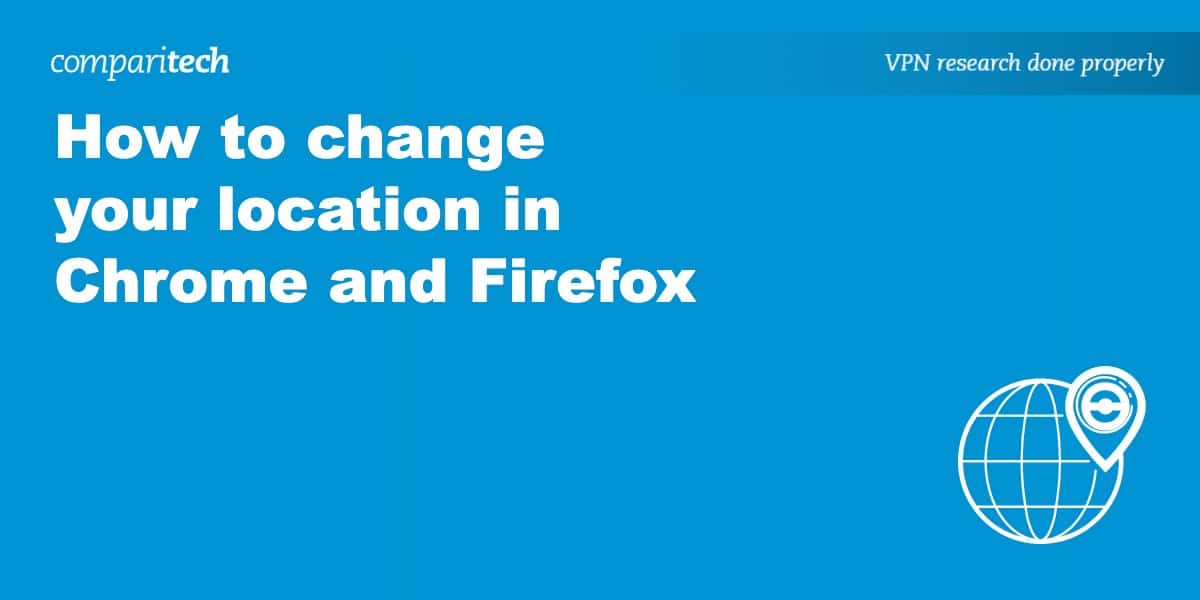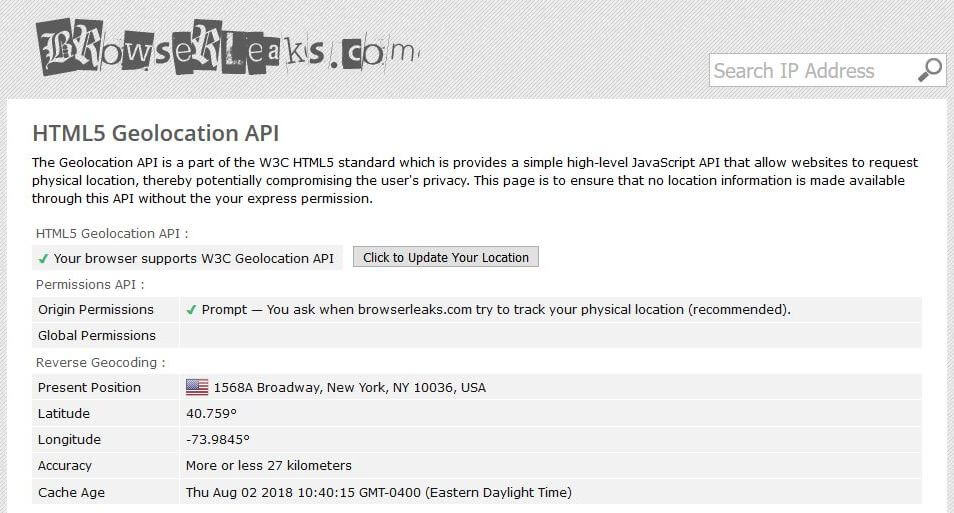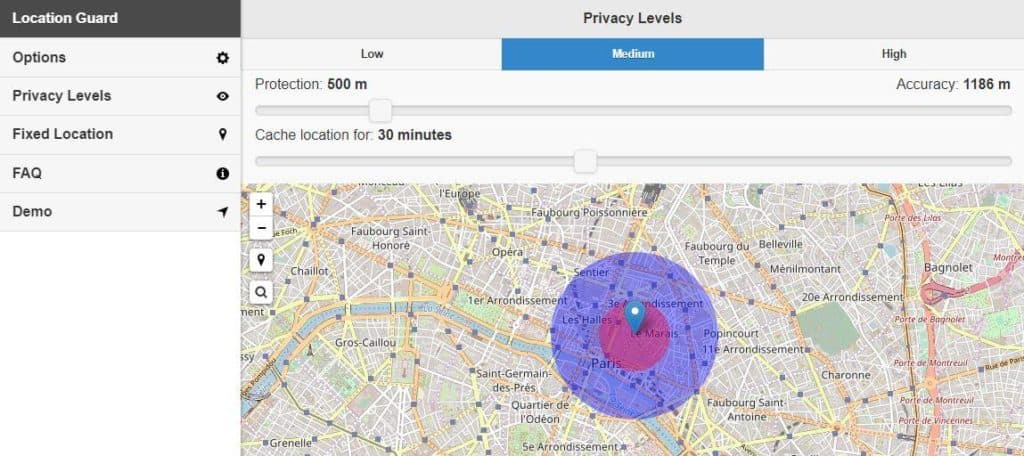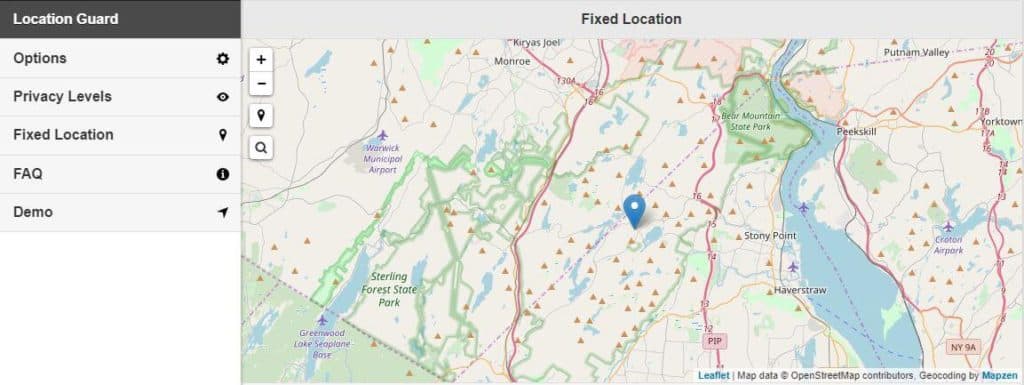Firefox and Chrome browsers come with geolocation services that pinpoint your location accurately. Although this feature has its benefits, there are instances when you may want to hide, spoof, or change your browser’s location. Several methods are available, whether you wish to access region-locked content or safeguard your privacy.
We explore the various options to achieve your desired location change, ensuring you have all the necessary information to make informed decisions. Our team has conducted extensive research and testing to present you with reliable and effective techniques.
Some popular methods include using a Virtual Private Network (VPN), manually spoofing your location, or employing dedicated browser extensions. Depending on the situation, you may need to combine multiple methods to bypass different detection mechanisms. In this post, we’ll explore all of these options.
How to spoof your location using a VPN
Even if you’ve never used a VPN, setting one up is very straightforward. Here’s how to change your IP address in Firefox or Chrome with a VPN:
- Choose a provider, select a subscription term, and submit your payment. (We recommend NordVPN)
- Download the appropriate VPN software for your device. Most reputable VPN providers offer native apps for Windows, MacOS, iOS, and Android.
- Log in using your username and password (which will be provided when you signed up).
- Connect to a VPN server in the location of your choice. For example, if you want to watch US Netflix, you’d select a US server. You’ll now have a different IP address, making it appear you’re in that location.
However, it’s crucial to note that not all VPNs can unblock geo-restricted sites successfully. Streaming, gaming, and gambling services, among others, have developed ways to identify proxy usage, including VPNs. Many free VPNs may fall short of evading such detection. Before signing up for a VPN service, you should check with the provider to ensure it can grant access to your desired services (you can check here for VPNs working with Netflix, Amazon Prime, BBC iPlayer, and Hulu).
WANT TO TRY THE TOP VPN RISK FREE?
NordVPN is offering a fully-featured risk-free 30-day trial if you sign up at this page. This lets you use a zero-logs VPN with servers in 59 countries, without restriction, for a month — more than enough time to tell if it's a good fit or not.
There are no hidden terms—just contact support within 30 days if you decide NordVPN isn't right for you and you'll get a full refund. Start your NordVPN trial here.
How to spoof your location using HTML5
Spoofing your location using HTML5 can help you access region-specific content, bypass restrictions on certain websites, and protect your privacy. This section will discuss how to spoof your location in Chrome and Firefox using developer tools.
Chrome Browser
You can manually spoof your location using Chrome’s Developer Tools:
- Press Ctrl+Shift+I (Windows) or Cmd+Option+I (Mac) to open the Chrome Developer Tools window.
- Press Esc, then click the Console menu (the three dots to the left of Console in the lower portion of the screen).
- Select Sensors and change the Geolocation dropdown to Custom location.
- Enter any latitude and longitude you want.
Firefox Browser
You can manually change your location in Firefox using the about:config settings:
- Type about:config in the address bar and press Enter.
- Click “Accept the Risk and Continue” if prompted.
- Search for “geo.provider.network.url” and click the “Pen” icon to edit it. Replace the URL with a custom location using the format data:application/json,{“location”: {“lat”: LATITUDE, “lng”: LONGITUDE}, “accuracy”: ACCURACY}.
- Replace LATITUDE, LONGITUDE, and ACCURACY with the desired values.
Following these methods, you can successfully spoof your location using HTML5 in Chrome and Firefox browsers. Remember that some websites may still be able to detect your location through other means, such as your IP address. In such cases, consider using a VPN for additional privacy protection.
How Firefox and Chrome can detect your location
Let’s look at how Firefox and Chrome know where you are. One of the easiest ways for Firefox, Chrome, and any other online service to tell where you’re located is through your IP address. This unique set of digits (and symbols in the newer IPv6 addressing scheme) identifies each computer connected to the internet. Part of the IP address can be used to determine your location. As such, masking your real IP address and replacing it with another one can spoof your location, making it appear that you’re elsewhere.
However, some browsers have other methods that can decipher where you are. For example, they can use nearby wi-fi networks to geolocate devices without IP addresses. Turning off wi-fi and Bluetooth can be one option, but the likelihood is that you’ll need one or both of these, so it’s simply not an option for most users.
Using a VPN will enable you to easily change your IP address, replacing your existing one with another from a location of your choice. However, this may not bypass other geolocation services used by the browser. To overcome this issue, you can manually change your location in your browser or use an extension such as Location Guard.
Use a VPN to change your location in Firefox or Chrome
A Virtual Private Network (VPN) works by encrypting your internet traffic and tunneling it through an intermediary server. The two major benefits of a VPN are:
- Encryption: The encryption factor means your internet traffic is completely secure and no one can decipher it, even if they manage to intercept it. This applies to ISPs, government agencies, cybercriminals, and anyone else who might be snooping on your activity.
- Location spoofing: Because your traffic is tunneled through an intermediary server, you will be assigned an IP address from that server. When using a VPN, you can choose the location of the server you connect to and, hence, select where your IP address is from.
Note: the VPN will only spoof your location in terms of your IP address. So, even when using a VPN, your browser can detect your location. As such, you may need to manually spoof your location within the browser or use an extension like Location Guard (more on that below).
You’ll probably notice that some VPNs have dedicated browser extensions for Firefox, Chrome, and other browsers. These can be great for location spoofing, but note that most do not encrypt your internet traffic when used alone.
One extension that’s a bit different from the others is the addon provided by ExpressVPN. Its Chrome and Firefox extensions act as remote controls for the device-level VPN apps, but they also automatically adjust the browser’s geolocation services. As such, the detected location matches the VPN server you’re connected to. This means you don’t need to do anything else except connect to your chosen VPN server.
The best VPNs for changing location on Chrome and Firefox
You have hundreds (if not thousands) of VPNs to choose from, all of which allow you to change location on Chrome and Firefox, as well as Edge, Brave, and more.
All of the best VPNs for changing location on Chrome and Firefox provide desktop and mobile apps. Most also offer Chrome and Firefox browser extensions as well (although browser extensions only secure browser traffic):
- NordVPN: The best VPN for changing location on Chrome and Firefox. 6,000+ servers and fast connection speeds. Obfuscated and Double VPN servers. 24/7 support.
TIP In our testing we found that the cheapest NordVPN plan (Basic) works perfectly for Chrome and Firefox. - Surfshark: Best value VPN for changing browser location. High-speed servers in 100+ countries. Static IP addresses available and unlimited simultaneous device connections.
- IPVanish: One of the faster VPNs available. Ideal for streaming and torrenting. Secure all of your devices at once. Owns and operates its servers. Comes with a free SOCKS5 proxy.
- CyberGhost: Huge network of more than 11,500 servers makes it perfect for location spoofing. Very good speeds and easy-to-use apps. Strict no-logs policy protects privacy.
- ExpressVPN: Offer 3,000+ servers in 105+ countries with no bandwidth throttling. Highly secure with built-in obfuscation and and an audited no-logs policy.
- ProtonVPN: A large server network, with a presence in 112+ countries. Fantastic security features including 256-bit encryption, DNS leak protection, multi-hop servers and a no-logs policy.
- PureVPN: Over 6,000 servers in 65+ countries for great international coverage. Exceptionally fast speeds for streaming and downloading. Built-in obfuscation.
- PrivateVPN: Servers in 63+ countries and consistent access to streaming platforms. Free remote help and installation available. No-logs policy – not even connection logs.
VPNs often claim to keep you safe and private online but many VPNs (especially free ones) leak information.
We regularly test the top 70 VPNs for security and this list only includes VPNs which keep you anonymous and don't track your activity. Plus we only recommend VPNs which offer a full-money back guarantee allowing you to try them risk free.
Our top choice for changing location: NordVPN
Apps Available:
- PC
- Mac
- IOS
- Android
- Linux
- FireTV
VPN Ratings:
| Overall score: | 9.5 / 10 |
|---|---|
| Streaming: | 9.2 / 10 |
| Speed: | 9.8 / 10 |
| Security & Privacy: | 9.5 / 10 |
| Ease of Use: | 9.6 / 10 |
| Value for Money: | 9.5 / 10 |
Website: www.NordVPN.com
Money-back guarantee: 30 DAYS
We’ve rigorously tested a number of the top-rated VPNs, and NordVPN comes out on top each time. Indeed, this is the VPN provider we recommend for use with Firefox and Chrome.
Based in Panama, NordVPN operates a network of more than 6,000 servers spanning 111+ countries. It provides users with exceptionally fast, reliable connections. We know this because we tested it against seven other providers. You can see how it performed in the chart below (you can read more about our VPN testing process later in the article).
The provider’s fast speeds and SmartPlay technology make it ideal for streaming. It can unlock far more geo-restricted sites than most providers. We successfully used it with Netflix US (and other Netflix libraries), Hulu, HBO, BBC iPlayer, and Amazon Prime Video without issue.

If you have issues finding the right server to connect to, a 24/7 live chat customer service agent is always available to help.
Every NordVPN subscription includes apps for Windows, MacOS, Linux, iOS, and Android. Chrome and Firefox users can download dedicated browser extensions that can be used as remote controls for the appropriate VPN app.
When you connect to a server, NordVPN’s browser extension will automatically change your Firefox or Chrome geolocation data to match the VPN location you’re connected to. This means that as long as you’re using the VPN, you never have to worry about changing any settings manually; just connect to the appropriate server, and you’re good to go.
NordVPN is just as impressive when it comes to privacy and security. It uses effectively uncrackable 256-bit encryption, and this comes with perfect forward secrecy. You also get the best leak protection in the industry and a built-in kill switch. This means you can rest assured your data will always remain safe inside the encrypted tunnel. Use the chart below to see how NordVPN compares with the other VPN providers we tested in terms of security and privacy.
NordVPN subscriptions allow up to 10 simultaneous device connections per account. the service is also compatible with some home routers. Configuring a router connection allows you to change the virtual location of every device on your home network.
Buy this VPN if:
- You want the best selection of secure IP addresses available
- You want access to speciality servers for accessing the dark web
- You want a VPN for streaming
- You want fast speeds
Don’t buy this VPN if:
- You want port forwarding
BEST VPN FOR CHANGING BROWSER LOCATION:NordVPN is our top recommendation. It has thousands of RAM-only servers worldwide, so you can get an IP address from almost anywhere. Fast speeds make it ideal for streaming, and there is a 30-day money-back guarantee.
Read our full review of NordVPN.
How to manually spoof your location
If you’re just setting up Firefox or Chrome, you’ll be asked if you want to allow location services as part of the setup process. You can simply deny this request, and for Firefox, you can skip the first set of instructions below.
But chances are you’ll do this after the initial setup. In this case, you’ll need to manually turn the geolocation services off. Plus, it doesn’t help changing your location, so you’ll need to do that manually, too.
Manually change your location in Firefox
Here’s how to spoof your location in Firefox:
- Type about:config in your browser. A warning will pop up to tell you about the risk involved in altering the advanced settings. As long as you’re happy to go ahead, click I accept the risk!
- Look for the setting geo.enabled.
- The value column should read “true.” Double click it to set it to “false.”
Note that this will only stop Firefox tracking your location. To set a new location, you can continue with the following steps:
- Still in about:config, look for the setting geo.wifi.uri.
- Change this to the location you want to “be” in. To do this, you have to enter a specific longitude and latitude value. You can use the following line of code but replace the values:
data:application/json,{"location": {"lat": 40.7590, "lng": -73.9845}, "accuracy": 27000.0}
The above example from a Stack Exchange user will put you in Times Square, but you can change it to wherever you want by tweaking the latitude and longitude values. There are plenty of tools to help you find out these numbers such as GPS Coordinates and LatLong.net.
Note that if you ever want to revert back to the default settings, you can right click anywhere on the geo.wifi.uri row and select Reset.
Manually change your location in Chrome
In Chrome, you can use the following instructions to spoof your location:
- In a browser window, hit Ctrl+Shift+I (for Windows) or Cmd+Option+I (for MacOS). This will open the Chrome Developer Tools window.
- Hit Esc, then click the Console menu (three dots to the left of Console in the lower portion of the screen).
- Select Sensors and change the Geolocation dropdown to Custom location…
- Enter any latitude and longitude you want.
Alternatively, you can choose one of the preset options in the Geolocation menu, including Berlin, Mumbai, or San Francisco.
Note that for the location override to work in Chrome, you have to keep the developer tools open and stay in the same browser window. If you open a new window, it will revert back to your original location. This is different from Firefox where you can open multiple windows and still have your location spoofed.
To check if these processes have worked in either browser, you can test it using a tool such as BrowserLeaks.
In the above screenshot, you can see that we managed to spoof our location to make it appear that we were actually in Times Square.
Use the Location Guard addon
If you’re happy to let an addon do the work for you, you might want to try Location Guard. This extension has two major uses:
- Lower accuracy of location detection: If you’re concerned about privacy but still want to appear that you’re in the same general location, you can use this extension to hide your exact location. This means you can still enjoy the perks of geolocation services (such as local search results), without having to let browsers and third parties know exactly where you are. You can choose the level of “noise” added depending on how much you want to mask your location.
- Spoof your location: Another option is to use Location Guard’s Fixed Location feature which basically does what we did earlier: enables you to select an exact location you want to appear to be in.
To use the Fixed Location feature:
- Install the Location Guard extension for Firefox or Chrome.
- Go to Options and change Default Level to Use fixed location.
- Go to Fixed Location and choose a location on the map. You can either find your desired location manually or enter an address in the search bar. Just make sure that you “place” the pointer in your desired location — you’ll have to actually click on the map to put it in place.
Location Guard’s setup is an arguably easier option than the manual steps we outlined earlier. Plus, the extension offers an attractive and intuitive interface. Although, there is the issue that you’re using another extension, so it might not be the most ideal option for privacy-conscious users. While it worked for us, there have been complaints from some users that it hasn’t worked consistently.
WebRTC blocking
One more factor to be concerned about is WebRTC leaks. WebRTC, or Web Real-Time Communication helps facilitate audio and video browser-to-browser communication. It is built into many browsers, including Firefox and Chrome. Even when using a VPN, WebRTC can pose a risk by potentially exposing your real IP address.
Many VPNs build WebRTC protection into their software, but this is often limited to actual VPN apps, and doesn’t typically carry over to browser extensions. Some do include WebRTC leak protection in their extensions, such as NordVPN, but if you’re going with another provider, you might need to take extra precautions.
Is it possible to disable WebRTC in your browser to avoid the issue altogether? Here’s how to disable WebRTC leaks in Firefox:
- Enter about:config in your Firefox address bar.
- Find media.peerconnection.enabled.
- If the Value column says “true,” then double-click the row so that it reads “false.”
There is no similar method to do this in Chrome. However, there are extensions available that can prevent WebRTC leaks, including WebRTC Leak Prevent.
You can check to see if these methods have worked using BrowserLeaks.
Read more browser articles here:
Methodology: How we chose the best VPNs for changing browser location
We concentrated on the following areas to find the best overall provider:
Speed
All VPNs slow your connection a little due to the additional routing and encryption processes needed to create a secure tunnel. However, some are much, much faster than others. To find out which will best preserve your base connection speed, we carried out speed tests in the morning, at noon, and in the afternoon. We used VPN servers in the UK, US and Japan to get an idea of global speeds.
The tests were carried out on a virtual machine which has been rate limited to 250 Mbps. We chose this figure as it’s the median download speed for broadband users in the US and therefore gives users a good idea of how each VPN would realistically perform.
The chart below shows the test results while connected to a UK server. The final column shows the average speeds across all three locations.
The fastest providers for the UK were NordVPN, Surfshark and Private VPN. These three providers were also the fastest when speeds from the US and Japan were taken into account.
Server availability
If you’re changing your virtual location with a VPN, the number of location options available will depend on where the VPN has servers. We scored providers on the number of countries they have a presence in. We also took into account the number of servers in their networks, as this helps determine their relative availability.
CyberGhost combines a vast network with a presence in 100 countries, so it’s not surprising it leads the scores in this category. NordVPN is the next best option, with 6,600 servers in 111+ countries.
Security & privacy
It’s important to choose a VPN that keeps your connection private and secure. Many don’t, which is why we thoroughly evaluate each provider before recommending them. In all, we use 16 different criteria for calculating security and privacy scores.
Ease of use
To find out which VPNs provide the easiest to use service, we score them against 10 different criteria and combine the results.
Streaming
Only a few VPNs provide access to geo-restricted content from all of the big-name platforms. If this is important to you, choose one of the VPNs that score highly in the chart below. This represents the combined scores for nine metrics related to streaming.
As you can see, NordVPN, Surfshark and ExpressVPN are all particularly good options for streaming.
Change your location in Chrome and Firefox: FAQs
Can I use a DNS proxy instead of a VPN?
It is possible to use a DNS proxy service in place of a VPN for the IP address component of location spoofing. However, you should bear in mind two major differences between VPNs and proxy servers.
The first is that a DNS proxy will only change your location if you’re visiting a site that requires geo-unblocking. For any other site, the proxy won’t kick in, and you’ll get a direct connection to that site. This means if you want privacy, a DNS proxy won’t provide it. Plus, while a DNS proxy can technically help you unblock geo-restricted content, the reality is that many are unable to bypass some heavy proxy crackdowns such as those rolled out by Netflix and BBC iPlayer.
The second big difference is that most DNS proxy services won’t encrypt your internet traffic. This means that if it’s intercepted, anyone can decipher your information. If privacy and security are concerns, then you’re better off with a VPN.
Can I use a free VPN to change my IP address?
Free VPNs will pop up all the time in your search, but these are generally not good options. For starters, in a similar vein to DNS proxies, they are less likely to be able to bypass the geo-restriction measures taken by certain sites. So chances are you won’t be able to access your favorite shows, movies, or games. What’s’ more, servers are few and far between and tend to be overloaded. Even if you can bypass restrictions, you could end up with a slow, unreliable connection.
Additionally, free VPNs tend to have rather strict data limits. If you’re looking to effectively use a VPN service for anything more than basic web browsing, you’ll find a free VPN is extremely limited.
If you’re more concerned about privacy and security, free VPNs fall short there too. Various services have been known to track user activity, sell information to third parties, and inject ads into the sites you visit. Some fail to encrypt your data and could even carry malware. It’s definitely worth the few extra bucks for a top-rated provider.
Is it legal to change your location in Chrome?
The good news is that it’s legal to change your location in Chrome, Firefox, or any other browser you choose to use. Indeed, VPNs are legal in the vast majority of countries and are a great way to secure your online activity and bypass geographic restrictions. Remember, illegal online activities such as torrenting copyrighted material are still illegal regardless of whether you’re using a VPN.
Do these VPNs work on other browsers?
Yes, VPNs can work on other browsers, such as Microsoft Edge, Safari, and Opera. Each browser has its own set of instructions for setting up a VPN connection, and users should refer to the specific instructions for their preferred browser. However, it is important to note that some older versions of browsers may not be compatible with certain VPN services or protocols. Additionally, it may be necessary to install additional plugins or extensions to establish a successful connection. Therefore, it is best to consult the documentation provided by your chosen VPN provider before attempting to configure a connection using an unsupported browser.
Another thing to consider is that although some browsers are more secure than others when used without a VPN, they might still leak unencrypted data while connected with one. This can be avoided by selecting a browser compatible with your chosen VPN service or using one of the more secure browsers, such as Chrome or Firefox.
Can my real location be exposed?
Although a VPN is designed to hide your real location, there are instances where it might be exposed, such as when your VPN connection drops or due to a DNS leak. However, reputable VPN providers implement advanced security features like kill switches and DNS leak protection to prevent your actual location from being exposed, ensuring your privacy and security at all times.
Wrapping up
Because browsers have multiple methods in place to detect your location, to truly spoof your location, you may need to use a couple of methods. Our recommended solution is to use a VPN and manually change your location in your browser. If you find that too cumbersome (it’s a little more difficult in Chrome), then trying the Location Guard extension alongside a VPN could be a very viable solution.

















Unfortunately, despite even using the pre-determined locations in the latest Chrome Sensor box, it still shows my default location using the websites you mentioned. I exited Chrome and then relaunched everything Developer’s box. I have my location disabled. Do you know what I am doing wrong?
today is 12.1.2020
your most recent update is
11.27.2020
firefox 78.5.0esr
geo.wifi.uri is not an option (about:config)
For some reason it’s not listed alphabetically, but it should show up if you enter it in the search bar.
Hi Aimee,
I have to agree with r’s comment, the option doesn’t exist anymore. It did give me the option to create it myself, but unfortunately it didn’t seem to fix my issue.
But in Firefox 84.0.1, the option is no longer there.
Thank you. This is really helpful to solve my issue.. Thank you.
Chrome and firefox methods don’t work. I have read many blogs that have the same steps, but they don’t change the location in Google. Example: I get the lat & long for beaumont, texas, plug that into Google dev tools, run my “family lawyer” search but I still get results for my local area, not beaumont texas. When I follow the steps for firefox, same thing.
Am I doing something wrong?
Some websites will employ additional measures to detect your location. In the case of Google, you also need to turn off the location tracking features within the account. You can read more about this here: https://www.comparitech.com/blog/vpn-privacy/stop-google-apple-microsoft-tracking-location/